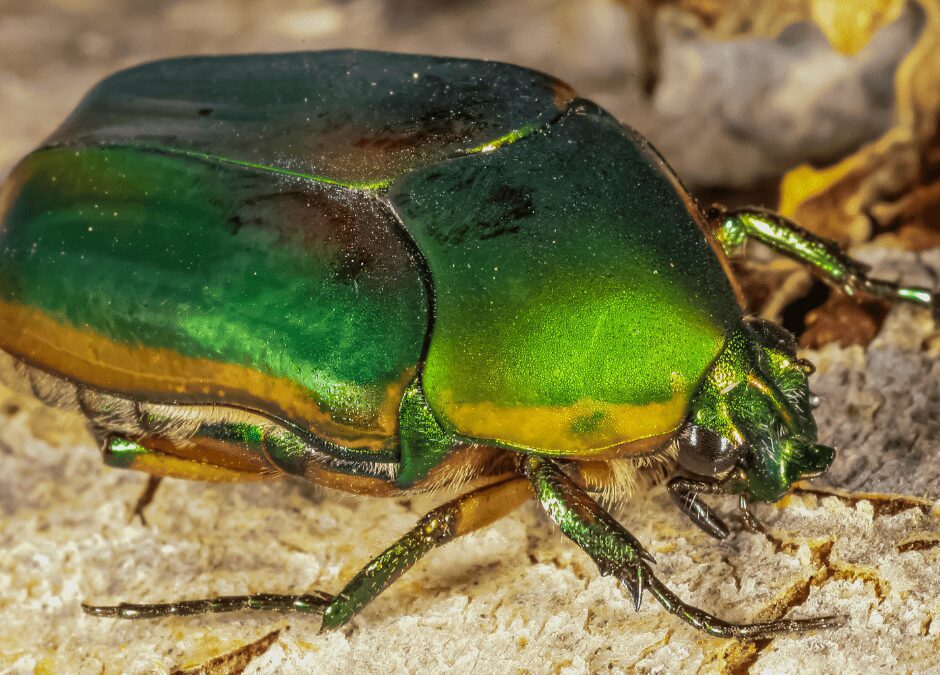Just when you thought you were done with grubs, Green June Beetles start showing up in our area. They lay their eggs in the soil and as the eggs hatch, the larvae begins happily munching away at the roots of our turfgrasses, veggies and ornamental plants too! Adult beetles love to target thin-skinned fruits (think figs) and other fruits too. It’s a little frustrating that just as we’ve come through summer and fighting off regular June Bugs, that these new pests appear. However, we did want to make you aware of Green June Beetles in case you start seeing decline in your turf or plant material in your landscape that you can’t attribute to drought damage or a recurrent fungal issue.

4 Signs You Have Green June Beetles
1. Small, unearthed piles throughout your turfgrass or in your gardens that could be mistaken for earthworm casting or little ant hills. The mounds are about 2″-3″ in diameter and have a distinct burrow opening that is about the diameter of your thumb. The length of the burrow channel usually runs around 6″ – 12″ deep into the soil.
2. The Green June Beetle itself. This 1″-1.5″ long beetle will zip past you and have you thinking you’ve been buzzed by a bumblebee. They practically make the same sound. The females are early risers and you can find them hovering above turfgrass in the wee morning hours, while males will shuffle out around mid morning. They are actually kind of pretty with their shiny, metallic-green hue but that’s about all the good I have to say about them.
3. Larvae feeding at night. Grubs are c-shaped and are usually found tunneling into the top 4″ of soil. The larvae will burrow up from the soil to feed at night. You can find them doing something pretty strange in the evening. They have a peculiar way of crawling along on their backs instead of using their very capable (but small) legs. Go figure!
4. Spots and damage on your thin-skinned fruits. Adult Green June Beetles love to feed on ripe stone fruit crops, figs, raspberries and quince (and plenty of other things too). They burrow inside of the fruits and leave their, ahem, waste behind. Ewww.

Control of Green June Beetles
Control of Green June Beetles is the same as the control options for their cousins, the coppery colored June/May Beetle:
- Beneficial Nematodes can be applied to your affected areas and are a very effective control for these pests, AS LONG AS you can keep the soil moist. Beneficial nematodes need to be watered in well in order to be able to swim down through the soil and do their dirty work .
- Watering before, or applying beneficial nematodes after a rainstorm (or during if you don’t care about looking crazy) is a great way to know your nematodes have got off to a great start. You’ll need to water afterwards as well as continue to keep the soil moist in order for this control to keep working. kind of hard when we are on water restrictions, but those are the facts.
- Chemical control with a product containing the active ingredient imidacloprid is also very effective at eradicating the larvae of these beetles. Bonide Insect & Grub is a commonly purchased product for Green June Beetles. These products will also need to be watered in after applying them.
Once the weather truly cools down, Green June Beetles will head back into the soil and overwinter in its depths. When spring arrives, the stinkers will emerge again in spring to feed and mate, so if you have an abundance of them, you might think about getting rid of them now.


Thank you! I wondered what they were.
Please add my email address to your newsletter list.
Hi Sandy,
I’m glad the article helped you out. We will need you to sign up for the newsletter at this link, as our format does not allow us to add individuals without a consent process. It’s super easy to do. We have 2 newsletters you can opt for: One that contains gardening tips and our articles, and one that delivers our weekly ads straight to your email. You can opt for both if you’d like. Thanks you!
I had over one hundred flying around in my back yard yesterday under a shade tree they where on ground in clumps of 12/15 I figured mating so I had to wait four hours until they went back in ground to mow my yard but it was great watching them
You are a GOOD person for allowing them their ‘time” Ha!
I just want them GONE!! My yard is way too big to water so is there any other way to control them? I have 100’s of them!
The techniques in the blog (beneficial nematodes, or the chemical imidacloprid), are the controls that we can vouch for. And yes, you need to water them in for them to be effective.
I am so terrified of these green bugs. I run a fireworks tent and need help to get rid of them. What can I do?
Hi Latasha,
We’d recommend the advice in this blog you posted on which includes either applying beneficial nematodes, or using a systemic insecticide such as Bonide Insect and Grub. As for them flying around your stand (if they do), it will be somewhat difficult to avoid, especially if your fireworks stand is lit up which I assume it is. This control is for the grubs (larvae form) of the June Beetle to prevent them from emerging from the soil. I don’t have a remedy for adults that fly around.